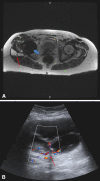The John Charnley Award: Diagnostic accuracy of MRI versus ultrasound for detecting pseudotumors in asymptomatic metal-on-metal THA
- PMID: 23868425
- PMCID: PMC3890209
- DOI: 10.1007/s11999-013-3181-6
The John Charnley Award: Diagnostic accuracy of MRI versus ultrasound for detecting pseudotumors in asymptomatic metal-on-metal THA
Abstract
Background: The prevalence of pseudotumors in patients with large-head metal-on-metal (MOM) THA has been the subject of implant recalls and warnings from various regulatory agencies. To date, there is no consensus on whether ultrasound or MRI is superior for the detection of pseudotumors.
Questions/purposes: We prospectively compared ultrasound to MRI for pseudotumor detection in an asymptomatic cohort of patients with MOM THAs. We also compared ultrasound to MRI for assessment of pseudotumor growth and progressive soft tissue involvement at a 6-month interval.
Methods: We enrolled 40 patients with large-head MOM THAs in the study. The mean age was 54 years (range, 34-76 years). The mean time from surgery was 54 months (range, 40-81 months). There were 28 men and 12 women. All patients underwent ultrasound and MRI using slice encoding for metal artifact correction. The gold standard was defined as follows: if both ultrasound and MRI agreed, this was interpreted as concordant and the result was considered accurate.
Results: Ultrasound and MRI agreed in 37 of 40 patients (93%). The prevalence of pseudotumors was 31% (12 of 39) in our cohort. Twenty-three of 39 patients (59%) had completely normal tests and four (10%) had simple fluid collections. Ultrasound had a sensitivity of 100% and specificity of 96% while MRI had a sensitivity of 92% and specificity of 100%.
Conclusions: A negative ultrasound rules out pseudotumor in asymptomatic patients as this test is 100% sensitive. Given its lower cost, we recommend ultrasound as the initial screening tool for pseudotumors.
Figures

Similar articles
-
What Is the Natural History of Asymptomatic Pseudotumors in Metal-on-metal THAs at Mid-term Followup?Clin Orthop Relat Res. 2017 Feb;475(2):433-441. doi: 10.1007/s11999-016-4981-2. Clin Orthop Relat Res. 2017. PMID: 27444034 Free PMC article.
-
Do patients with a failed metal-on-metal hip implant with a pseudotumor present differences in their peripheral blood lymphocyte subpopulations?Clin Orthop Relat Res. 2015 Dec;473(12):3903-14. doi: 10.1007/s11999-015-4466-8. Epub 2015 Sep 1. Clin Orthop Relat Res. 2015. PMID: 26324830 Free PMC article.
-
Higher Prevalence of Mixed or Solid Pseudotumors in Metal-on-Polyethylene Total Hip Arthroplasty Compared With Metal-on-Metal Total Hip Arthroplasty and Resurfacing Hip Arthroplasty.J Arthroplasty. 2018 Jul;33(7):2279-2286. doi: 10.1016/j.arth.2018.02.011. Epub 2018 Feb 12. J Arthroplasty. 2018. PMID: 29526334
-
Understanding outcomes and toxicological aspects of second generation metal-on-metal hip implants: a state-of-the-art review.Crit Rev Toxicol. 2018 Nov;48(10):853-901. doi: 10.1080/10408444.2018.1563048. Epub 2019 Mar 26. Crit Rev Toxicol. 2018. PMID: 30912993 Review.
-
Metal-on-metal total hip arthroplasty: risk factors for pseudotumours and clinical systematic evaluation.Int Orthop. 2017 May;41(5):885-892. doi: 10.1007/s00264-016-3305-1. Epub 2016 Oct 20. Int Orthop. 2017. PMID: 27761629 Review.
Cited by
-
[Mid- and long-term effectiveness and failure causes analysis of large-head metal-on-metal total hip arthroplasty].Zhongguo Xiu Fu Chong Jian Wai Ke Za Zhi. 2017 Feb 15;31(2):144-149. doi: 10.7507/1002-1892.201605122. Zhongguo Xiu Fu Chong Jian Wai Ke Za Zhi. 2017. PMID: 29786243 Free PMC article. Chinese.
-
Revision total hip arthroplasty for metal-on-metal failure.J Clin Orthop Trauma. 2020 Jan-Feb;11(1):9-15. doi: 10.1016/j.jcot.2019.09.021. Epub 2019 Oct 4. J Clin Orthop Trauma. 2020. PMID: 32001977 Free PMC article. Review.
-
The surgical options and clinical evidence for treatment of wear or corrosion occurring with THA or TKA.Clin Orthop Relat Res. 2014 Dec;472(12):3674-86. doi: 10.1007/s11999-014-3652-4. Clin Orthop Relat Res. 2014. PMID: 25024023 Free PMC article. Review.
-
What is appropriate surveillance for metal-on-metal hip arthroplasty patients?Acta Orthop. 2018 Feb;89(1):29-39. doi: 10.1080/17453674.2017.1398011. Epub 2017 Nov 6. Acta Orthop. 2018. PMID: 29105547 Free PMC article.
-
Complications Related to Metal-on-Metal Articulation in Trapeziometacarpal Joint Total Joint Arthroplasty.J Funct Biomater. 2015 May 25;6(2):318-27. doi: 10.3390/jfb6020318. J Funct Biomater. 2015. PMID: 26020592 Free PMC article.
References
-
- Bellamy N, Buchanan W, Goldsmith CH, Campbell J, Stitt LW. Validation study of WOMAC: a health status instrument for measuring clinically important patient relevant outcomes to antirheumatic drug therapy in patients with osteoarthritis of the hip or the knee. J Rheumatol. 1988;15:1833–1840. - PubMed
MeSH terms
LinkOut - more resources
Full Text Sources
Other Literature Sources
Medical

